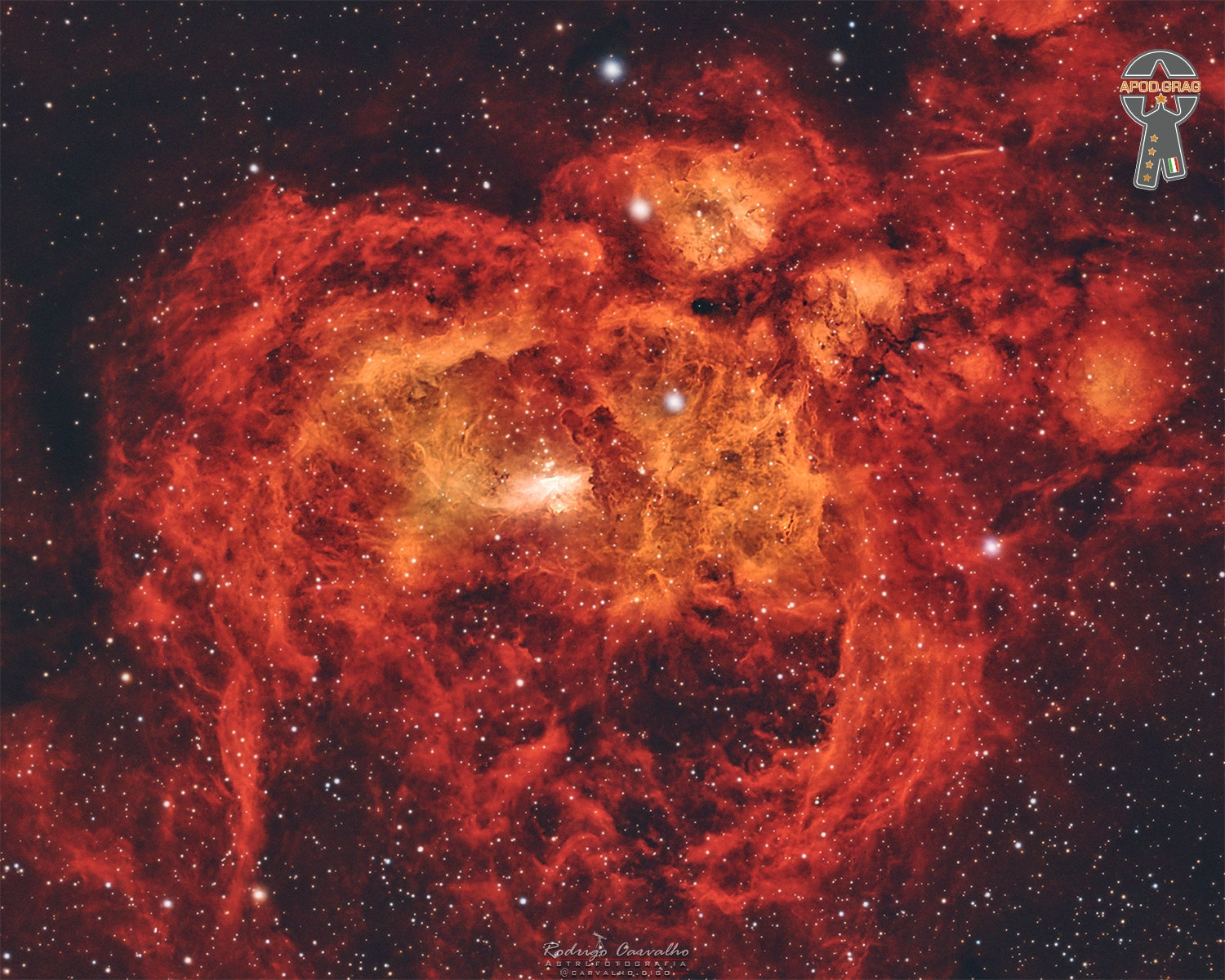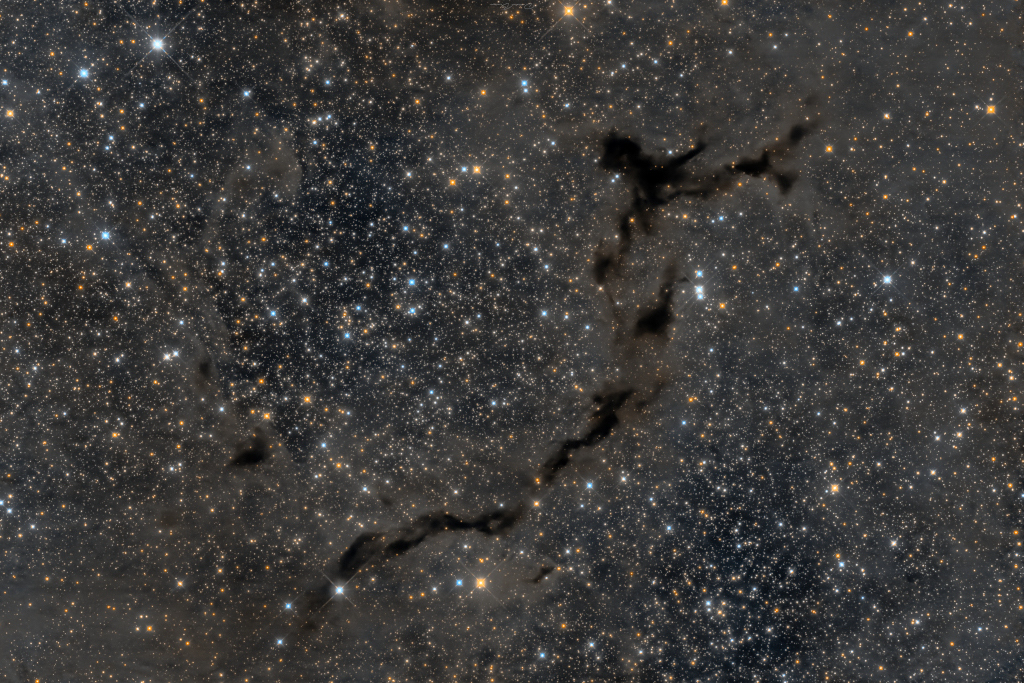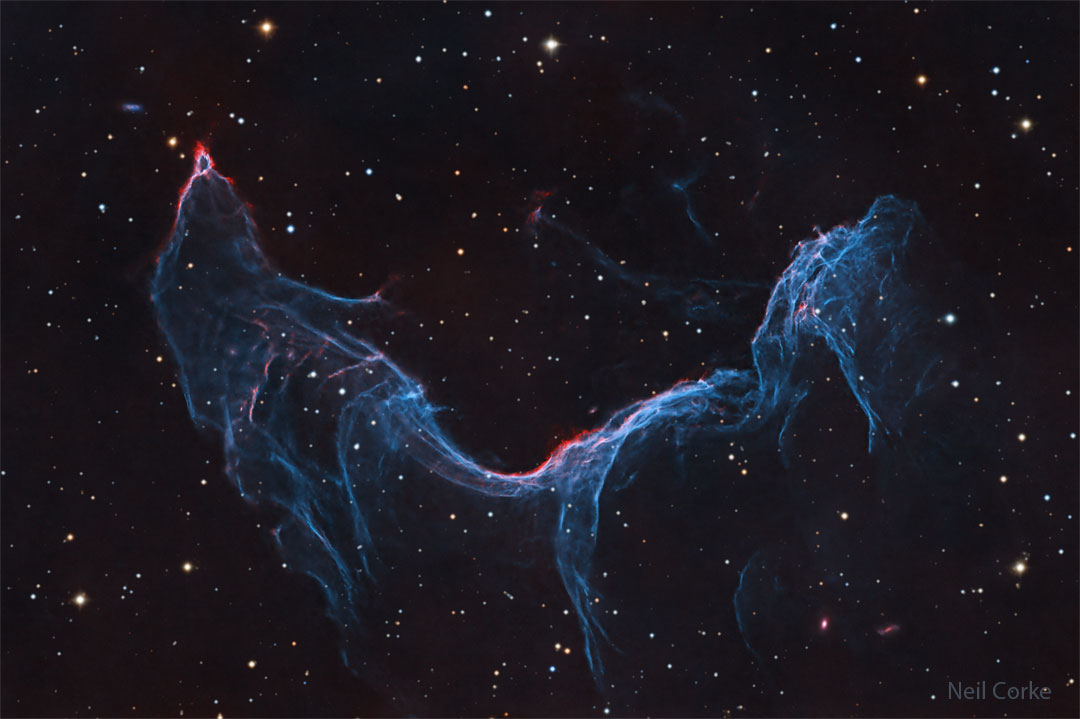Blog
NGC 6357 is a diffuse nebula near NGC 6334 in the constellation Scorpius. The nebula contains many proto-stars shielded by dark discs of gas, and young stars wrapped in expanding “cocoons” or expanding gases surrounding these small stars. It is also known as the Lobster Nebula. This nebula was given the name War and Peace Nebula by the Midcourse Space Experiment scientists because of its appearance, which, in infrared images the bright, western part resembles a dove, while the eastern part looks like a skull. A petition by anime fans to rename it as the Madokami nebula, due to resemblance with a character, was unsuccessful.
It is located about 5,500 light years away from Earth.

Leonard Norman Cohen CC GOQ (September 21, 1934 – November 7, 2016) was a Canadian singer-songwriter, poet, and novelist. Themes commonly explored throughout his work include faith and mortality, isolation and depression, betrayal and redemption, social and political conflict, and sexual and romantic love, desire, regret, and loss. He was inducted into the Canadian Music Hall of Fame, the Canadian Songwriters Hall of Fame, and the Rock and Roll Hall of Fame. He was invested as a Companion of the Order of Canada, the nation’s highest civilian honour. In 2011, he received one of the Prince of Asturias Awards for literature and the ninth Glenn Gould Prize.
Cohen pursued a career as a poet and novelist during the 1950s and early 1960s, and did not begin a music career until 1966. His first album, Songs of Leonard Cohen(1967), was followed by three more albums of folk music: Songs from a Room (1969), Songs of Love and Hate (1971) and New Skin for the Old Ceremony (1974). His 1977 record Death of a Ladies’ Man, co-written and produced by Phil Spector, was a move away from Cohen’s previous minimalist sound.
In 1979, Cohen returned with the more traditional Recent Songs, which blended his acoustic style with jazz, East Asian, and Mediterranean influences. Cohen’s most famous song, “Hallelujah“, was released on his seventh album, Various Positions(1984). I’m Your Man in 1988 marked Cohen’s turn to synthesized productions. In 1992, Cohen released its follow-up, The Future, which had dark lyrics and references to political and social unrest.
Cohen returned to music in 2001 with the release of Ten New Songs, a major hit in Canada and Europe. His eleventh album, Dear Heather, followed in 2004. In 2005, Cohen discovered that his manager had stolen most of his money and sold his publishing rights, prompting a return to touring to recoup his losses. Following a successful string of tours between 2008 and 2013, he released three albums in the final years of his life: Old Ideas (2012), Popular Problems (2014), and You Want It Darker(2016), the last of which was released three weeks before his death. His posthumous, fifteenth, and final studio album Thanks for the Dance, was released in November 2019.
In 2023, Rolling Stone ranked him number 103 in their “200 Greatest Singers of All Time” list.
more...James Marcellus Arthur “Sunny” Murray (September 21, 1936 – December 7, 2017) was an American musician, and was one of the pioneers of the free jazz style of drumming.
Murray was born in Idabel, Oklahoma, where he was raised by an uncle who later died after being refused treatment at a hospital because of his race. He began playing drums at the age of nine. As a teen, he lived in a rough part of Philadelphia, and spent two years in a reformatory. In 1956, he moved to New York City, where he worked in a car wash and as a building superintendent. During this time, he played with musicians such as trumpeters Red Allen and Ted Curson, pianist Willie “The Lion” Smith, and saxophonists Rocky Boyd and Jackie McLean.
more...Charles Thomas Potter (September 21, 1918 – March 1, 1988) was an American jazz double bass player, best known for having been a member of Charlie Parker‘s “classic quintet”, with Miles Davis, between 1947 and 1950.
Born in Philadelphia, Pennsylvania, Potter had first played with Parker in 1944, in Billy Eckstine‘s band with Dizzy Gillespie, Lucky Thompson and Art Blakey.
Potter also performed and recorded with many other notable jazz musicians, including Earl Hines, Artie Shaw, Bud Powell, Count Basie, Sonny Rollins, Stan Getz, Max Roach, Eddie Heywood, Tyree Glenn, Harry “Sweets” Edison, Buck Clayton and Charles Lloyd.
more...Leroy Eliot “Slam” Stewart (September 21, 1914 – December 10, 1987 Englewood, NJ) was an American jazz double bass player, whose trademark style was his ability to bow the bass (arco) and simultaneously hum or sing an octave higher. He was a violinist before switching to bass at the age of 20.
Stewart found regular session work throughout the 1940s with Lester Young, Fats Waller, Coleman Hawkins, Erroll Garner, Art Tatum, Johnny Guarnieri, Red Norvo, Don Byas, Benny Goodman, and Beryl Booker. One of the most famous sessions he played on took place in 1945, when Stewart played with Dizzy Gillespie‘s group (which featured Charlie Parker). Out of those sessions came some of the classics of bebopsuch as “Groovin’ High” and “Dizzy Atmosphere“.
He taught at Binghamton University in Binghamton, New York, and at Yale University. He died of congestive heart failure on December 10, 1987, in Binghamton, aged 73.
more...Mt Zion Shabbat for the Soul Friday September 20th 2024 630pm with Jennifer Truss-Klien, Tami Morse and mick laBriola.
more...The Seahorse Nebula floats in silhouette against a rich, luminous background of stars. Seen toward the royal northern constellation of Cepheus, the dusty, dark nebula is part of a Milky Way molecular cloud some 1,200 light-years distant. It is also listed as Barnard 150 (B150), one of 182 dark markings of the sky cataloged in the early 20th century by astronomer E. E. Barnard. Packs of low mass stars are forming within, but their collapsing cores are only visible at long infrared wavelengths. Still, the colorful Milky Way stars of Cepheus add to this stunning galactic skyscape.

more...
Billy Bang (September 20, 1947 – April 11, 2011), born William Vincent Walker, was an American free jazz violinist and composer.
He later joined Sun Ra‘s band. In 1977, Bang co-founded the String Trio of New York (with guitarist James Emery and double bassist John Lindberg). Bang explored his experience in Vietnam in two albums: Vietnam: The Aftermath (2001) and Vietnam: Reflections (2005), recorded with a band which included several other veterans of that war. The latter album also features two Vietnamese musicians based in the United States (voice and đàn tranh zither).
The film Billy Bang Lucky Man documents his return to Vietnam in 2008 to collaborate with Vietnamese musicians and come to terms with his experiences in the war. A soundtrack album was released in 2021.
more...
Keith Moore “Red” Mitchell (September 20, 1927 – November 8, 1992 NY,NY) was an American jazz double-bassist, composer, lyricist, and poet.
Mitchell performed and/or recorded with Mundell Lowe, Chubby Jackson, Charlie Ventura, Woody Herman, Red Norvo, Gerry Mulligan, and, after joining the West Coast jazz scene in the early 1950s, with André Previn, Shelly Manne, Hampton Hawes, Billie Holiday, Stan Seltzer, Ornette Coleman, and others such as Mahalia Jackson. He also worked as a bassist in television and film studios around Los Angeles, occasionally appearing on screen. Mitchell also appeared in documentaries about Tal Farlow and Zoot Sims.
Saxophonist Harold Land and Mitchell founded and co-led a quintet in the early 1960s.
Mitchell moved to Stockholm in 1968. He won Sweden’s Grammis Award in 1986 and again in 1991, for his recorded performances as a pianist, bassist, and vocalist, and for his compositions and poetic song lyrics.
more...Elvira Louise Redd (September 20, 1928 – February 6, 2022) was an American jazzalto saxophone player, vocalist and educator. She was active from the early 1950s and was known primarily for playing in the blues style. She was highly regarded as an accomplished veteran, and performed with Count Basie, Rahsaan Roland Kirk, Linda Hopkins, Marian McPartland and Dizzy Gillespie.
Redd was born on September 20, 1928, in Los Angeles, California, the daughter of New Orleans jazz drummer and Clef Club co-founder Alton Redd and Mattie Redd (née Thomas). Her mother played saxophone, although not professionally, and her brother was a percussionist. She was deeply influenced during her formative years by her father, who was one of the leading figures on the Central Avenue jazz scene. Another important musical mentor was her paternal great aunt Alma Hightower, who convinced the 10-year-old Redd to switch from piano to saxophone. During junior high school, Redd played alto saxophone in a band with Melba Liston and Dexter Gordon.
more...Foreststorn “Chico” Hamilton (September 20, 1921 – November 25, 2013 LA,CA) was an American jazz drummer and bandleader. He came to prominence as sideman for Lester Young, Gerry Mulligan, Count Basie, and Lena Horne. Hamilton became a bandleader, first with a quintet featuring the cello as a lead instrument, an unusual choice for a jazz band in the 1950s, and subsequently leading bands that performed cool jazz, post bop, and jazz fusion.
Foreststorn Hamilton was born in Los Angeles, California, one of three brothers, one of whom was actor Bernie Hamilton.
Hamilton started his career in a band with Charles Mingus, Illinois Jacquet, Ernie Royal, Dexter Gordon, Buddy Collette and Jack Kelso before he had finished high school.Engagements with Lionel Hampton, Slim & Slam, T-Bone Walker, Lester Young, Count Basie, Duke Ellington, Charlie Barnet, Billy Eckstine, Nat King Cole, Sammy Davis Jr., Billie Holiday, Gerry Mulligan and Lena Horne established his career.
more...Zapateado as an instrumental flamenco music form is said to have the polyrhythm of 3/4, 2/4, 6/8… This reminds us of another polyrhythmic flamenco style: Tanguillos, ‘little tangos’ from Cadiz. One of the old Zapateado music pieces was actually called Zapateado de Cadiz, which was danced by historic Spanish dancers such as Josefa Varga in 1840’s. In that era, however, the dance style must have been rather close to ballet. How should Zapateado be danced now? Polyrhythm is a format of mixed rhythm, hence incites experiments with rhythms. Not having a singer, how can we make the instrumental music more interesting and decorative? By percussion. In this way, it was completely fine that Lucero Tena performed Zapateado with castanets. The important thing is, despite the name, the percussive sound is rather supplementary, not essential, for the music of Zapateado, because those music pieces are already beautiful without.
New stars are born from the remnants of dead stars. The gaseous remnant of the gravitational collapse and subsequent death of a very massive star in our Milky Way created the G296.5+10.0 supernova remnant, of which the featured Mermaid Nebula is part. Also known as the Betta Fish Nebula, the Mermaid Nebula makes up part of an unusual subclass of supernova remnants that are two-sided and nearly circular. Originally discovered in X-rays, the filamentary nebula is a frequently studied source also in radio and gamma-ray light. The blue color visible here originates from doubly ionized oxygen (OIII), while the deep red is emitted by hydrogen gas. The nebula’s mermaid-likeshape has proven to be useful for measurements of the interstellar magnetic field. 190,000ly

David Bromberg (born September 19, 1945 Philadelphia, PA) is an American multi-instrumentalist, singer, and songwriter. An eclectic artist, Bromberg plays bluegrass, blues, folk, jazz, country and western, and rock and roll. He is known for his quirky, humorous lyrics, and the ability to play rhythm and lead guitar at the same time.
Bromberg has played with many famous musicians, including Jerry Jeff Walker, Willie Nelson, Jorma Kaukonen, Jerry Garcia, Rusty Evans (The Deep) and Bob Dylan. He co-wrote the song “The Holdup” with George Harrison, who played on Bromberg’s self-titled 1972 album. In 2008, he was nominated for a Grammy Award. Bromberg is known for his fingerpicking style that he learned from Reverend Gary Davis.
more...Ellen Naomi Cohen (September 19, 1941 – July 29, 1974 Baltimore, MD), known professionally as Cass Elliot, was an American singer. She was also known as “Mama Cass“, a name she reportedly disliked. Elliot was a member of the singing group the Mamas & the Papas. After the group broke up, she released five solo albums. Elliot received the Grammy Award for Best Contemporary (R&R) Performance for “Monday, Monday” (1967). In 1998, she was posthumously inducted into the Rock and Roll Hall of Fame for her work with the Mamas & the Papas.
Elliot left that party at 8:00 p.m. on Sunday, July 28 1973 , saying she was tired and needed to get some sleep.
Elliot retired to an apartment in Mayfair at Flat 12, 9 Curzon Place (later Curzon Square), Shepherd Market, Mayfair, London, owned by singer-songwriter Harry Nilsson who allowed her to stay there. Several hours after Elliot left Jack Martin’s cocktail party, she died in her sleep at age 32. Her body was discovered by a close friend of hers who went to check on her. According to Keith Simpson, who conducted her autopsy, she died of a heart attack, and there were no drugs in her system. Four years later, Keith Moon, drummer for The Who, died in the same bedroom, also aged 32 years.
more...More Posts
- Lalgudi Jayaraman Day
- Earl May Day
- JackMcDuff Day
- Hank Williams Day
- Louis Nelson Day
- World Music with the National Arab Orchestra w/ Lubana Al Quntar & Mai Farouk
- Daily Roots with Prince Far I
- Surviving the Pandemic and Realizing Racial Justice
- The Cosmos with M98
- Earl Klugh Day
- Charlie Byrd Day
- B. B. King Day
- Madurai Shanmukhavadivu Day
- World Music with Lido Pimienta
- Daily Roots with Soul Syndicate & King Tubby
- Surviving the Pandemic and Realizing Racial Justice
- The Cosmos with Arp 273
- Cannonball Adderley Day
- Ram Ramirez Day
- Arvell Shaw Day
